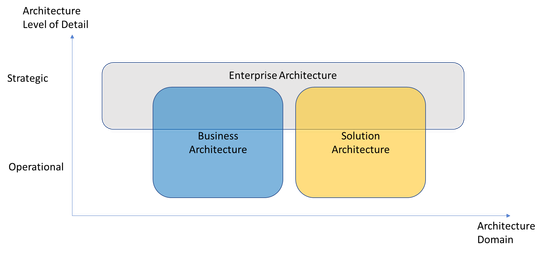- SAP Community
- Groups
- Interest Groups
- Enterprise Architecture
- Discussions
- Enterprise Architecture and Solution Architecture
- Subscribe to RSS Feed
- Mark Topic as New
- Mark Topic as Read
- Float this Topic for Current User
- Bookmark
- Subscribe
- Mute
- Printer Friendly Page
Enterprise Architecture and Solution Architecture
- Mark as New
- Bookmark
- Subscribe
- Mute
- Subscribe to RSS Feed
- Permalink
- Report Inappropriate Content
06-04-2022 4:21 PM
Connect Different Architecture Disciplines & Contexts
In the community, the question of the relation between Enterprise Architecture and Solution Architecture has been raised.
Enterprise Architecture aims to advance the strategic decision-making on how to organize an enterprise with its business value creation and the supporting IT.
Therefore Enterprise Architecture typically plays on a strategic level.
The SAP Enterprise Architecture (EA) Framework addresses aspects of the Business Architecture Domain and Solution Architecture Domain, their components, and their relationships to each other.
Both Business Architecture and Solution Architecture can describe experts' shared understanding and decisions[1] on a strategic and operational level.
Figure 1 illustrates the relationship between Enterprise Architecture and Solution Architecture.
Figure 1 - Business and Solution Architecture in Enterprise Architecture
Not all aspects of Business Architecture or Solution Architecture belong to the strategic level of Enterprise Architecture, but both domains and their relationship play a crucial role in Enterprise Architecture.
Architecture groups within these domains address topics such as organization, authorization, processes, data, and security, to name only a few.
A principle of the SAP EA Framework is consistently connecting the strategic Solution Architecture within EA to the operational Solution Architecture level.
This connection allows customers a smooth transition from strategic decision preparation to the actual implementation of software or services with only a minimal set of hiccups.
The consistent connection allows the mapping from high-level process descriptions to run-time relevant artifacts such as events, APIs, and middleware content.
The linkage fosters the synergetic collaboration of Enterprise Architects and more technically oriented architects in the Enterprise. Enterprise Architecture provides technical architecture visibility on the management level; the underlying operational architecture level makes Enterprise Architecture more tangible.
Georg Hophe's book "The Software Architect Elevator" (O'Reilly, 2020) outlines the importance of every architect's ability to work and communicate on different levels within organizations: "to convey technical topics to upper management" and "translate (business strategy) into technical decisions."
I want to recommend reading the books if you haven't had the chance!
This consistent connection of different architectural levels is just one principle of the SAP EA Framework. In addition, we plan to provide posts on other applied principles. We also plan to discuss the skills successful architects will need in the future.
I am heading NOW for a three-week vacation.
I look forward to your comments, feedback, and thoughts about Enterprise and Solution Architecture. Also, please let us know if you want to learn more about the characteristics of Enterprise, Business, and Solution Architecture in the SAP EA Framework.
Take care,
Andreas
[1] - Compare https://martinfowler.com/architecture/
- Mark as New
- Bookmark
- Subscribe
- Mute
- Subscribe to RSS Feed
- Permalink
- Report Inappropriate Content
10-31-2022 5:01 PM
I can completely relate to it now in my current role as an Enterprise Architect with focus on HR Platforms.
In my early career I was an ABAPer , then SAP HCM followed by SAP SuccessFactors solution for 11 years.
In my current role, I work along with team of Business Architects/Analysts as well as Solution architects and role is more strategic.
Regards,
Niladri
Niladri Bihari Nayak
